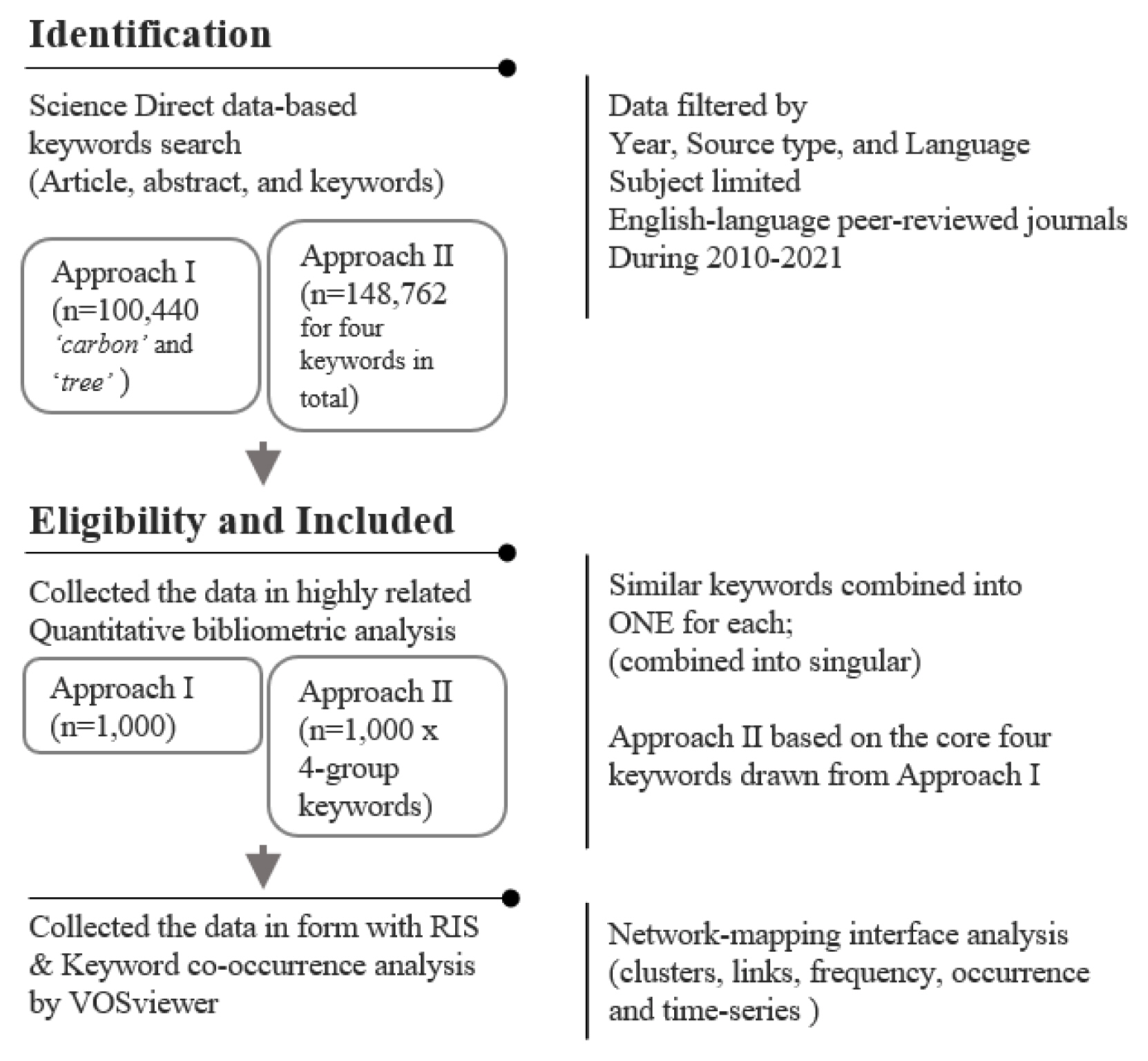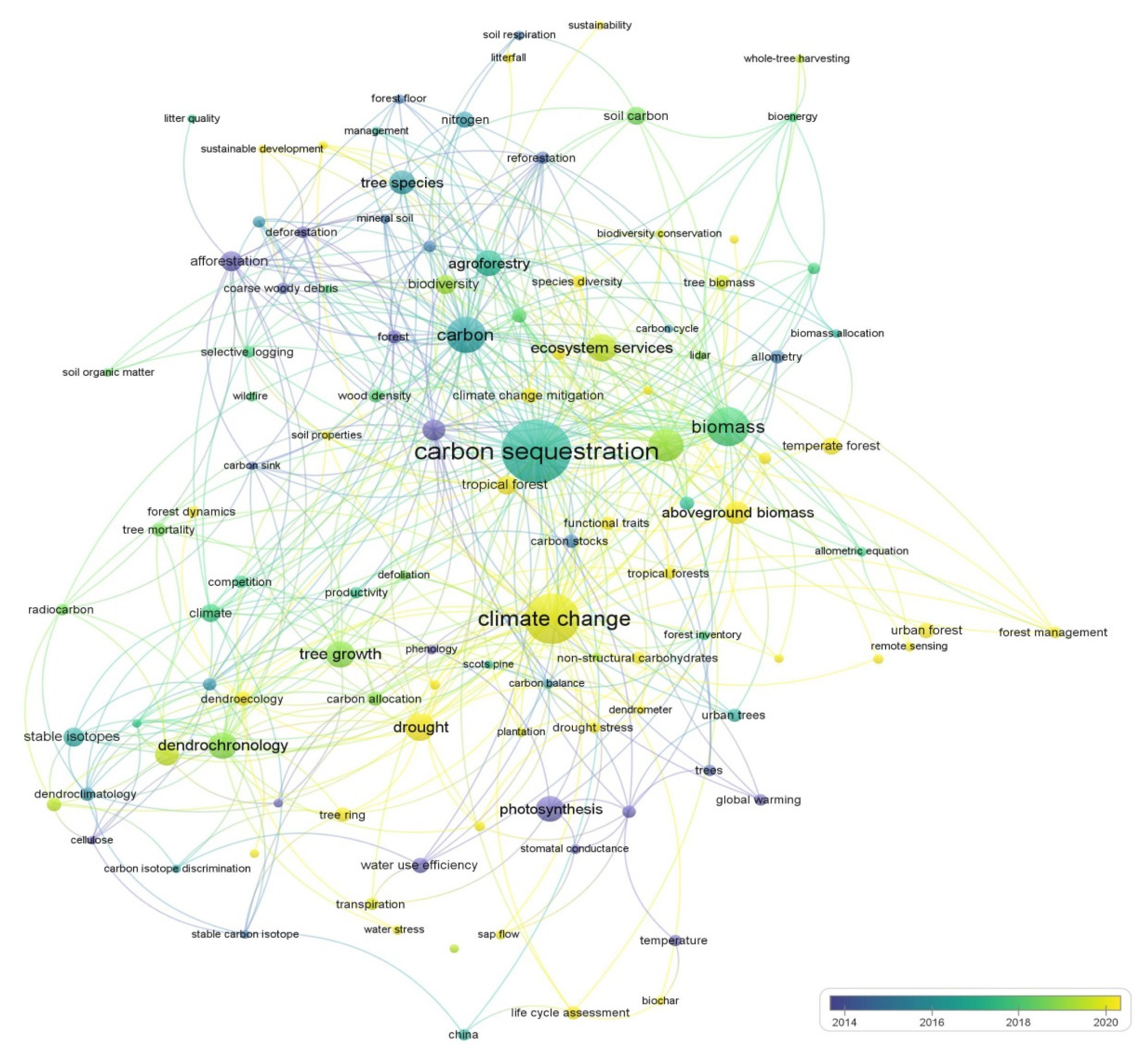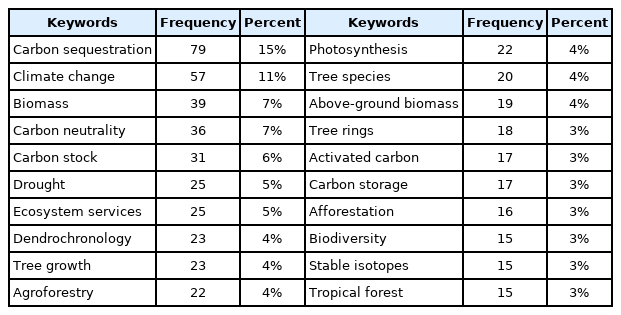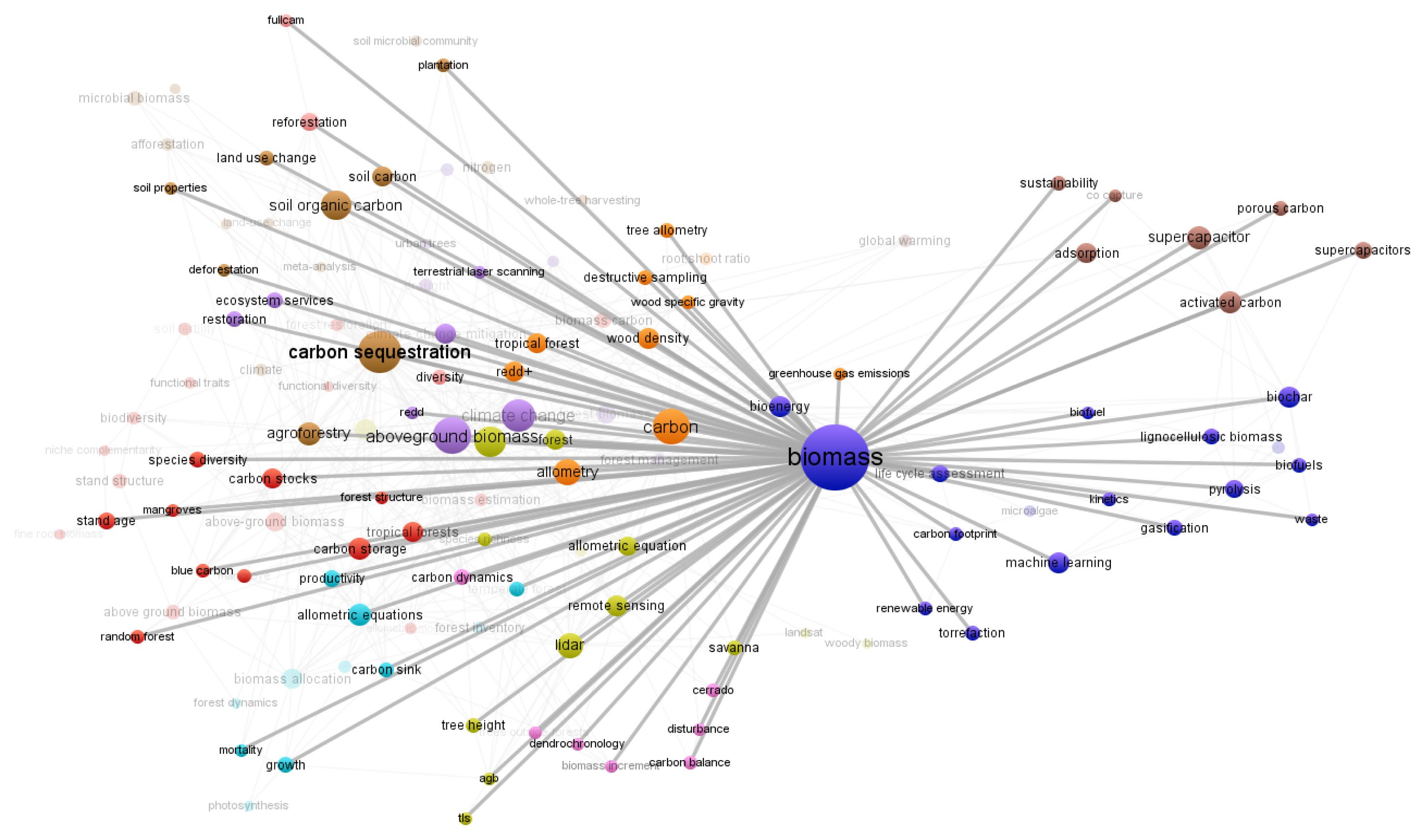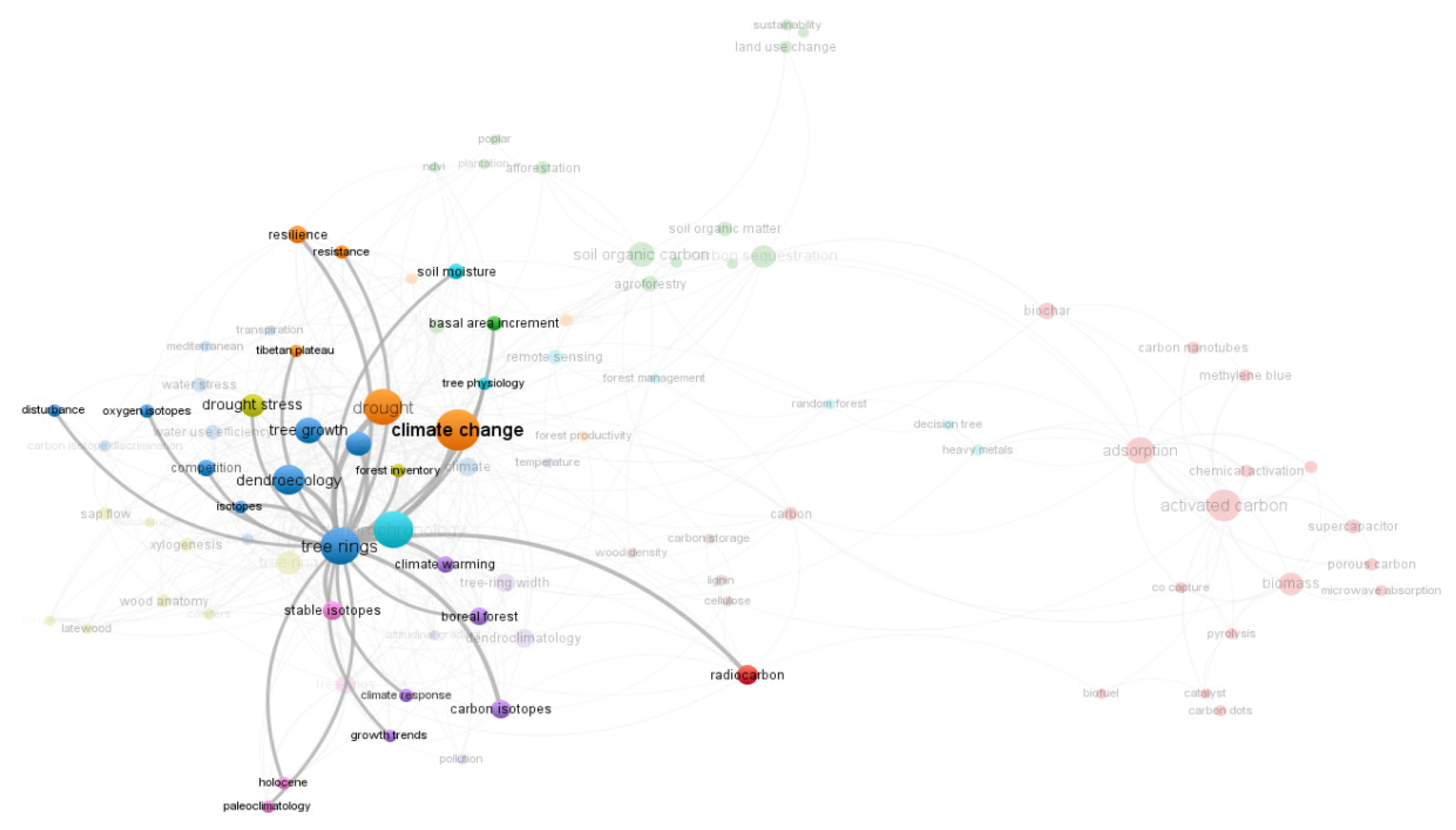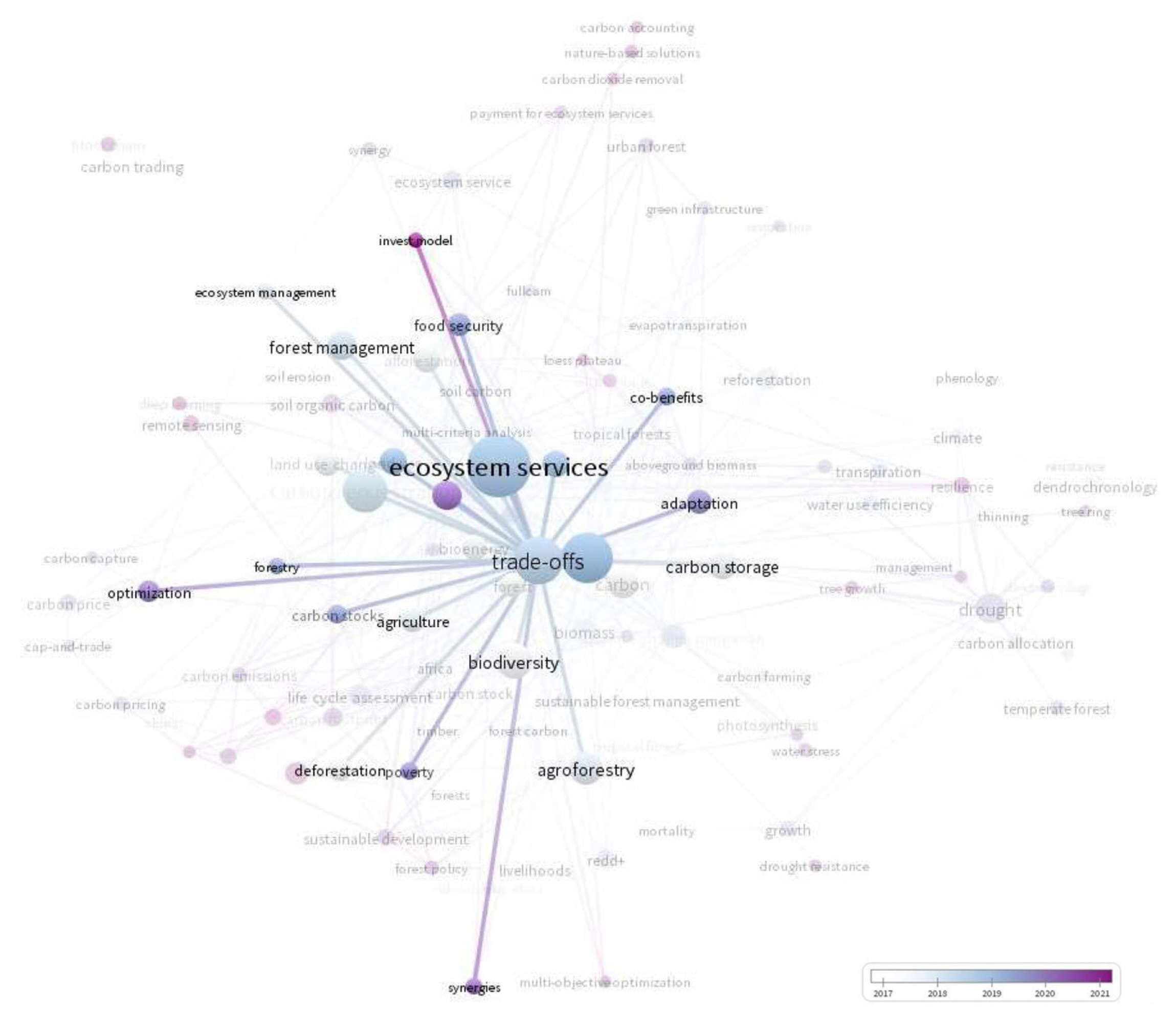Network Mapping Interface Analysis between Carbon and Trees Corresponding to Climate Change
Article information
Abstract
Background and objective
There have been increasing correlations between the keywords ‘carbon’ and ‘tree’ in response to issues related to climate change adaptation. Given this, a study that explores how these keywords relate to issues on climate change adaptation would be significant contribution to the literature. Therefore, this study aims to determine the correlation between these keywords and their network.
Methods
To address the aim, the study employed a bibliometric analysis using the VOSviewer software to conduct network-mapping interface analysis using co-occurrence-based visualization and quantification. A two-step approach was applied: the first approach identifies recent driver changes of the keywords ‘carbon’ and ‘tree’ and further meaningful keywords. The second approach conducts an in-depth network mapping analysis based on the results drawn by the first approach.
Results
The results suggested that, first, ‘carbon’ and ‘tree’ were shown to reflect the assessment system and contemporary issues based on the keywords ‘carbon sequestration’ and ‘climate change.’ In addition, ‘biomass,’ ‘tree growth,’ ‘tree ring’ and ‘trade-off’ were shown to be important keywords, which indicated the need for an in-depth correlation analysis. Second, ‘biomass’ was the key factor in the assessment system for ‘carbon sequestration,’ in which ‘tree growth’ and ‘tree ring’ were included. Third, the network analysis did not report varying results on ‘trade-off’ compared to ‘carbon’ and ‘tree’ with respect to the basic issues on climate change.
Conclusion
The conventional assessment system based on the keywords ‘carbon’ and ‘tree’ should be improved by incorporating the issues drawn from the keywords ‘biomass’ and ‘trade-off’ so that it may reflect the latest contemporary needs. The network analysis on the keywords ‘carbon’ and ‘tree’ nevertheless indicated that the two keywords were at the centre of the latest contemporary issues and the assessment system.
Introduction
There are increasing concerns over climate change, to the extent that it is considered one of the most critical environmental and economic problems worldwide (Solomon et al., 2007). Moreover, since the Glasgow Climate Pact adopted a plan to double the climate change adaptation fund by 2025, the issue of climate change has increasingly become a central priority. A newly emerging phrase in the Glasgow Climate Pact is Nationally Determined Contributions (NDCs), which is concerned with carbon neutrality and net-zero emissions. To address this goal, many suggestions have been made by different countries worldwide, with the overarching suggestion being to concurrently adopt nature-based solutions(NBS). NBS mainly focus on the use of vegetation or trees (Nagar et al., 2021). As such, many studies have explored various approaches to carbon reduction using trees. In terms of carbon reduction, generating biomass plays a crucial component in the carbon cycle (Sharma et al., 2016; Sagang et al., 2018). Chave et al. (2014), however, found that biomass alone is insufficient for calculating and predicting carbon storage or stock. Of greater importance is that the assessment of biomass requires various characteristics of trees to be measured. In line with this, there have been various factors that relate to carbon storage- i.e., with some considering carbon and tree growth (Zhang et al., 2022) and tree height (Williamson and Wiemann, 2010) and tree mortality (Lawrence et al., 2012). In these studies, correlations with individual factors were mainly analysed to estimate carbon storage or biomass. While there are various factors influencing biomass, different modelling methods have been suggested to complement the correlation assessment based on limited factors. The i-Tree Eco/Urban Forest Effects, i-Tree Eco, i-Tree Streets, and CUFR Tree Carbon Calculator are well-known models. However, when it comes to measuring restricted or regional relative growth (using allometric equations) and carbon storage using tree growth rate and dendrometric equations, results have shown that various factors still need to be considered to ensure the information provided using these methods is more reliable, consistent, and suitable to a given situation (Russoa et al., 2014). Furthermore, different findings have been revealed in terms of chronological variations. Thus, previous literature incorporating the use of trees allows for an understanding of the contemporary trend of the various influencing factors related to carbon, while revealing the need for a wider range of correlation analyses for these different factors. Thus, the following research objectives were set in this study: first, to investigate the trend in research using correlation analyses on the keywords carbon and tree, and second to identify a diversity of influencing factors using additional in-depth network analyses of the main keywords and factors.
Research Methods
Research scope and contents
The purpose of this study was to analyse the correlation between the keywords “carbon” and “tree” in terms of climate change adaptation, and to extend the correlation to determining the connectivity between these keywords by analysing the main clusters. Fig. 1 presents the overall procedures, including the network mapping interface analysis.
A search for the relevant literature was performed using a keyword analysis. Scientific and academic research papers were extracted using the Science Direct database, which contains a vast array of peer-reviewed papers that contributed to the bibliometric analysis. To ensure a comprehensive analysis, 1) the database was set as Science Direct; 2) the search conditions were limited to the English language and peer-reviewed papers; 3) the search strings were ‘carbon’ and ‘tree’ in the first approach, and the main clusters (e.g., biomass, tree growth, tree ring, and trade-off) in the second approach. Using the search strings ‘carbon’ and ‘tree’ in the first approach, 1,000 papers were extracted in order from the highest to the lowest correlation. Next, through the input of the main keywords in the second approach (biomass, tree growth, tree ring, and trade-off) and the search strings ‘carbon’ and ‘tree’, a total of 4,000 papers (1,000 papers for each keyword) were extracted in the order of correlation, and from these papers, the main keywords were drawn. The collected data were converted to an RIS file for the network mapping analysis using VOSviewer.
Network-Mapping Interface Analysis (NMIA)
Data collected from the papers of the Science Direct database in the bibliometric analysis were subsequently used in the network and time-series analyses via mapping. To achieve this, the correlations and patterns of the relevant studies found in the Science Direct database and other relevant environmental research were thoroughly examined in this study using the bibliometric analysis based on the author and index keywords using the VOSviewer software, ver. 1.6.18 (Van Eck and Waltman, 2014). VOSviewer visualizes and quantitatively presents the relative correlations across the keywords. To avoid the use of interchangeable or similar keywords and to enable simple network graphics, such keywords were combined into a single keyword. Co-occurrence analysis was performed to analyse the network of the correlations between terms and knowledge-based intellectual structures. In addition, the results of time-series analyses were color-coded per year for categorization and visualization of the identified trend.
Results and Discussion
First Approach analysis: Latest research trend obtained using NMIA
The result of the network mapping interface analysis with the search strings ‘carbon’ and ‘tree’ is shown in Fig. 2.
A total of 119 associated items, 9 clusters, and 659 links were analysed. The research trend per year indicated that mainstream research including the keywords ‘carbon’ and ‘tree’ began around 2014, when studies on key floral characteristics such as ‘afforestation’ and ‘photosynthesis’ related to forests were conducted in association with ‘carbon’ and ‘tree.’ Around 2016, the mainstream research was focused on carbon storage, including ‘carbon’ and ‘carbon sequestration.’ In 2018, the number of studies on ‘biomass’ for the assessment of carbon sequestration increased, with a greater focus on ‘tree growth.’ Around 2020, the trend of the key factors in the ‘biomass’ assessment were shown to have developed close associations with ‘tree-ring’ related to tree longevity and ‘climate change’ as part of global issues, in addition to ‘tree growth,’ on which previous studies have already been conducted. Hence, for ‘carbon’ and ‘tree,’ additional key factors were drawn, including ‘tree growth,’ ‘biomass’ and ‘tree-ring,’ for the ‘carbon sequestration’ assessment. This was taken as indicative of the deep association with the recent issue of ‘climate change.’ Table 1 presents the result of the frequency analysis obtained using VOSviewer in the first approach.
The most frequent items were ‘carbon sequestration (n = 79, 15%),’ ‘climate change (n = 57, 11%),’ ‘biomass (n = 39, 7%),’ ‘carbon neutrality (n = 36, 7%),’ ‘carbon stock (n = 31, 7%),’ ‘tree growth (n = 23, 4%)’ and ‘tree rings (n = 18, 3%),’ which were all among the 20 main extracted strings. The top 20 keywords were divided into two groups. The first group contained the key factors of the assessment system for carbon sequestration, namely the keywords ‘biomass,’ ‘carbon stock,’ ‘tree growth,’ ‘above-ground biomass,’ ‘tree rings’ and ‘carbon storage’ based on the keyword ‘carbon sequestration.’ The second group contained more comprehensive items related to climate change, namely the keywords ‘carbon neutrality,’ ‘drought,’ ‘dendrochronology,’ ‘agroforestry,’ ‘photosynthesis,’ ‘tree species,’ ‘afforestation,’ ‘biodiversity,’ ‘stable isotopes’ and ‘tropical forest’ based on the keyword ‘climate change.’ It should, however, be noted that, despite the categorization into two groups, strong network connectivity was found between the keywords ‘carbon sequestration’ and ‘climate change’ and for the strings associated with these two main items. To sum up, ‘ carbon’ and ‘tree’ were shown to reflect the assessment system and contemporary issues based on ‘carbon sequestration’ and ‘climate change,’ which created a strong network. This implies the need for an additional in-depth analysis of the strings in close associations with the keyword ‘assessment system,’ such as the keywords ‘biomass,’ ‘tree growth’ and ‘tree ring.’ Another implication is the need for a correlation analysis regarding how the key issues related to ‘climate change’ induce the trade-off on ‘carbon sequestration.’
Second approach analysis: In-depth NMIA
NMIA of keywords ‘carbon’, ‘tree’ and ‘biomass’
The result of the additional in-depth analysis with ‘biomass’ as the main keyword drawn from the network-mapping interface analysis of the keywords ‘carbon’ and ‘tree’ is shown in Fig. 3.
Through the analysis, a total of 10 clusters, 124 items, and 744 links were drawn. The number and occurrence of the links in direct associations with ‘biomass’ were 81 and 180, respectively. Fifteen items were direct keywords related to ‘biomass’: ‘biochar,’ ‘bioenergy,’ ‘biofuel,’ ‘biomass waste,’ ‘carbon footprint,’ ‘gasification,’ ‘kinetics,’ ‘life cycle assessment,’ ‘lignocellulosic biomass,’ ‘machine learning,’ ‘microalgae,’ ‘pyrolysis,’ ‘renewable energy,’ ‘torrefaction’ and ‘waste.’ The network associated with ‘tree’ based on ‘biomass’ was formed as ‘tree biomass’ in the connectivity of the cluster containing ‘carbon sequestration’ as the main keyword, but a direct and strong network with ‘biomass’ could not be clearly visualized.
In summary, research on biomass in association with trees was found to be inadequate in terms of quantity compared to other areas of research. However, a correlation analysis should be performed on the items forming a direct, strong network with ‘biomass’ in studies focused on ‘carbon,’ ‘tree’ and ‘biomass.’
NMIA of keywords ‘carbon,’ ‘tree’ and ‘tree growth’
The result of the additional in-depth analysis with ‘tree growth’ as the main keyword drawn from the network-mapping interface analysis of the keywords ‘carbon’ and ‘tree’ is shown in Fig. 4.
From the analysis performed using the VOSviewer network-mapping visualization, 9 clusters, 118 items, and 172 links were drawn. The quantitative outcome and connectivity were relatively weak compared to the network-mapping analysis on the keywords ‘carbon,’ ‘tree’ and ‘biomass.’ The number and occurrence of the links in the direct network of ‘tree growth’ were 43 and 41, respectively. Fifteen keywords were drawn: ‘allometric equation,’ ‘boreal forest,’ ‘carbon storage,’ ‘climate warming,’ ‘competition,’ ‘diversity,’ ‘facilitation,’ ‘fertilization,’ ‘forest management,’ ‘niche complementarity,’ ‘productivity,’ ‘species diversity,’ ‘stand structure,’ ‘thinning’ and ‘tree biomass.’ For ‘tree growth,’ numerous studies were found for the assessment system related to ‘carbon storage,’ while these studies mainly focused on the factors that influence ‘tree growth.’ A strong network was formed with ‘climate change’ and ‘tree ring’; however, these two strings were not in the same cluster as ‘tree growth.’ Additional strong networks were found with ‘dendrochronology,’ ‘dendroecology,’ ‘drought’ and ‘tree mortality.’
To sum up, research on ‘tree growth’ was weaker than that on ‘biomass’ based on the keywords ‘carbon’ and ‘tree.’ Nevertheless, as it is certain that ‘tree growth’ is a strong influencing factor of ‘climate change,’ more active research on this topic appears to be required. Furthermore, studies should be conducted based on the keywords and extended networks regarding ‘tree growth’ and other clusters.
NMIA of keywords ‘carbon’, ‘tree’, and ‘tree-ring’
The result of the additional in-depth analysis with ‘tree ring’ as the main keyword drawn from the network mapping analysis of the keywords ‘carbon’ and ‘tree’ is shown in Fig. 5.
From the analysis performed using the VOSviewer, 9 clusters, 92 items, and 442 links were drawn. Fourteen keywords were found to form a direct network interface with ‘tree ring’: ‘carbon isotope,’ ‘climate,’ ‘competition,’ ‘dendrochemistry,’ ‘dendroecology,’ ‘isotope,’ ‘Mediterranean,’ ‘oxygen isotope,’ ‘radial growth,’ ‘transpiration,’ ‘tree growth,’ ‘water stress’ and ‘water use efficiency.’ The number and occurrence of the links were 27 and 52, respectively. With other clusters, the network had strong connectivity with the issues of climate change, including ‘climate change,’ ‘drought,’ ‘drought stress’ and ‘climate warning.’ Notably, the overlay visualization in the time-series analysis also presented the concentrated distribution of studies related to ‘tree ring,’ with recent increases in the keywords ‘drought stress,’ ‘climate change’ and ‘growth trend’ as of 2021.
In turn, for the keyword ‘tree ring,’ a contribution was found across research on climate change adaptation, in addition to the factors from the assessment system for ‘carbon sequestration,’ as the indicators of tree longevity and life cycle that are associated with tree growth.
NMIA of keywords ‘carbon,’ ‘tree’ and ‘trade-off’
The result of the additional in-depth analysis and time-series analysis with ‘trade-off’ as the main keyword drawn from the network mapping analysis of the keywords ‘carbon’ and ‘tree’ is shown in Fig. 6.
Through the analysis performed using the VOSviewer network mapping (overlay visualization), 11 clusters, 128 items, and 581 links were drawn. The number and occurrence of the links in the direct network of ‘ trade-off’ were 41 and 58, respectively. The average publication year (APY) was 2018.5, while the APY for the ‘climate change’ cluster was 2019.01, indicating that research on ‘trade-off’ could have been active during a similar period or prior to the time that issues on climate change were emphasized. Most studies on ‘trade-off’ around 2017 were closely associated with carbon assessment regarding ‘carbon sequestration,’ ‘carbon storage’ and ‘carbon stock’. Subsequently, strong associations were formed for the keyword ‘trade-off’ by more comprehensive and extended concepts such as ‘forest management,’ ecosystem management’ and ‘ecosystem service’ as the number of related studies increased. Since 2020, strong associations have been found with ‘sustainability’ and ‘invest-model.’ Thus, the need for an approach related to issues focused on carbon in more long-term perspectives should be recognized for the keyword ‘trade-off,’ while it is found that an emphasis has been placed on issues of investment since policies related to carbon credits were developed. Table 2 presents the frequency, percentage, and link strength of the top 30 keywords.
The top 10 keywords were as follows: ‘ ecosystem services,’ ‘climate change,’ ‘carbon sequestration,’ ‘biodiversity,’ ‘agroforestry,’ ‘drought,’ ‘carbon,’ ‘carbon storage,’ ‘forest management’ and ‘sustainability.’ These keywords had a link strength of 30 or above, indicating strong connectivity. This suggested that the conceptual approach related to the keyword ‘trade-off’ and the network analysis on the keywords ‘carbon’ and ‘tree’ did not vary significantly. Nevertheless, a significant difference was found when analysing the top 30 keywords after the top 10 keywords; ‘carbon trading,’ ‘carbon footprint’ and ‘trade-off analysis’ were drawn as the main keywords. In other words, the results indicated that attempts have been made in research to take a natural science approach to the offset of carbon with respect to the keyword ‘trade-off’ as well as a socio-scientific approach for strings such as ‘carbon trading’ and a general approach on the offset, carbon generation, and analytical methods. The network analysis on the keyword ‘trade-off’ thus suggested basic issues from the analysis of the keywords ‘carbon’ and ‘tree,’ as well as the extended scope of factors that influence the trade-off and the socio-scientific approach towards sustainability.
Newly emerging driver changes of carbon neutrality and its expandability
This study explored two keywords (carbon and tree)-based issues in relation to carbon neutrality in responding to climate change. Here, our findings challenge the status quo of newly emerging driver changes of carbon neutrality and its expandability from scientific to a socio-scientific approach. This means that the keyword ‘carbon’ brings about an economic context. This challenge to the status quo of how a lot of carbon & tree-related factors drawn in this study can be absorbed in carbon trading calls for further discussion. The literature, in particular Springer’s 2003 study on economic modelling for climate change and carbon emissions trading, can be categorised using an integrated assessment model (e.g., AIM, IGSM, MERGE and others), energy system model (e.g., POLES), emissions trading models (e.g., MACGEM), macroeconomic models (e.g., GTEM, EPPA, DEM-E3, etc.), and the CGE model. The models have been expanded under the Kyoto Protocol, but these do not involve tree-based carbon trading, meaning that the question of how tree-based carbon can be indexed in an economic carbon trading model is a big concern. Interestingly, the UK, which is one of a few countries to challenge and generate carbon credits sourced from woodland and peatland, sets the Woodland Carbon Code and Peatland Code. This is the first step under the UK’s legislation such as UK Forestry Standard (UKFS), and adheres to an offsetting mechanism which can be compensated by purchasing or trading a carbon credit (1 carbon credit equivalent 1 tonne of CO2e). Another study in the USA calculated 700 million tonnes of carbon where economic values could be equivalent to $14,300 million value(Nowak and Crane, 2002). However, two major carbon emission markets (European Union Allowances and Certified Emissions Reductions) do not reflect these values. Carbon trading markets based on the representative markets are exposed to a deficiency with regard to volatility stability (Lyu et al., 2020). This could be because of unaware of carbon credit and its economic quantification, revealing that the amount of carbon hasn’t been costed comprehensively as well as more importantly calculation system of tree-based carbon has yet a deficiency in terms of conversion system from tree-generated carbon to carbon credit. To sum up, an integrated system for tree-based carbon calculation should be established, and reflected in the value of carbon credits with a standard conversion system. This will ultimately promote an awareness of the value of tree-based carbon trading.
Conclusions
This study aimed to conduct a network-mapping interface analysis on the keywords carbon and tree with respect to the recent issues of climate change adaptation. The key issues drawn from the analysis were subsequently examined. VOSviewer was used for visualization and quantification of the network mapping based on co-occurrence.
The results suggested that first, for the keywords ‘carbon’ and ‘tree,’ the assessment system and contemporary issues were reflected based on the keywords ‘carbon sequestration’ and ‘climate change,’ and the need for an in-depth correlation analysis on the keywords ‘biomass,’ ‘tree growth,’ ‘tree ring’ and ‘trade-off’ was recognized. Second, for the keyword ‘biomass,’ a critical role in the assessment system for ‘carbon sequestration’ was defined, which included the keywords ‘tree growth’ and ‘tree ring,’ and it was also recognized that a variety of factors should be considered in addition to the conventional factors influencing the ‘carbon sequestration’ assessment system. Third, the network analysis of the keywords ‘trade-off’ showed that, in addition to the basic issues found from the results for the keywords ‘carbon’ and ‘tree,’ the scope of factors influencing trade-offs should be extended and a socio-scientific approach to sustainability should be taken.
In conclusion, the conventional assessment system based on the keywords ‘carbon’ and ‘tree’ should incorporate the extended issues drawn from the analysis of the keywords ‘biomass’ and ‘trade-off’ to reflect contemporary needs. Nevertheless, as shown by the result of the network analysis of the keywords ‘carbon’ and ‘tree,’ these two keywords were once again highlighted as being at the centre of the latest contemporary issues as well as the assessment system, a significant finding.
This study has certain limitations. As the network-mapping interface analysis was limited to addressing only the keywords ‘carbon,’ ‘tree,’ ‘biomass,’ ‘tree growth,’ ‘tree ring’ and ‘trade-off,’ additionally detected issues could not be analysed in-depth. As the analysis was also limited to the Science Direct database among the various other academic research databases, with a focus on overseas studies, the insights and analysis were limited to studies conducted in certain specific countries. These limitations should be resolved in further studies.
Notes
This paper is based on the findings of the research project (2022-012(R)) which was conducted by the Korea Environment Institute (KEI) and supported by the Korea Agency for Infrastructure Technology Advancement (KAIA) grant funded by the Ministry of Land, Infrastructure and Transport (Grant 22UMRG-C158194-03).

